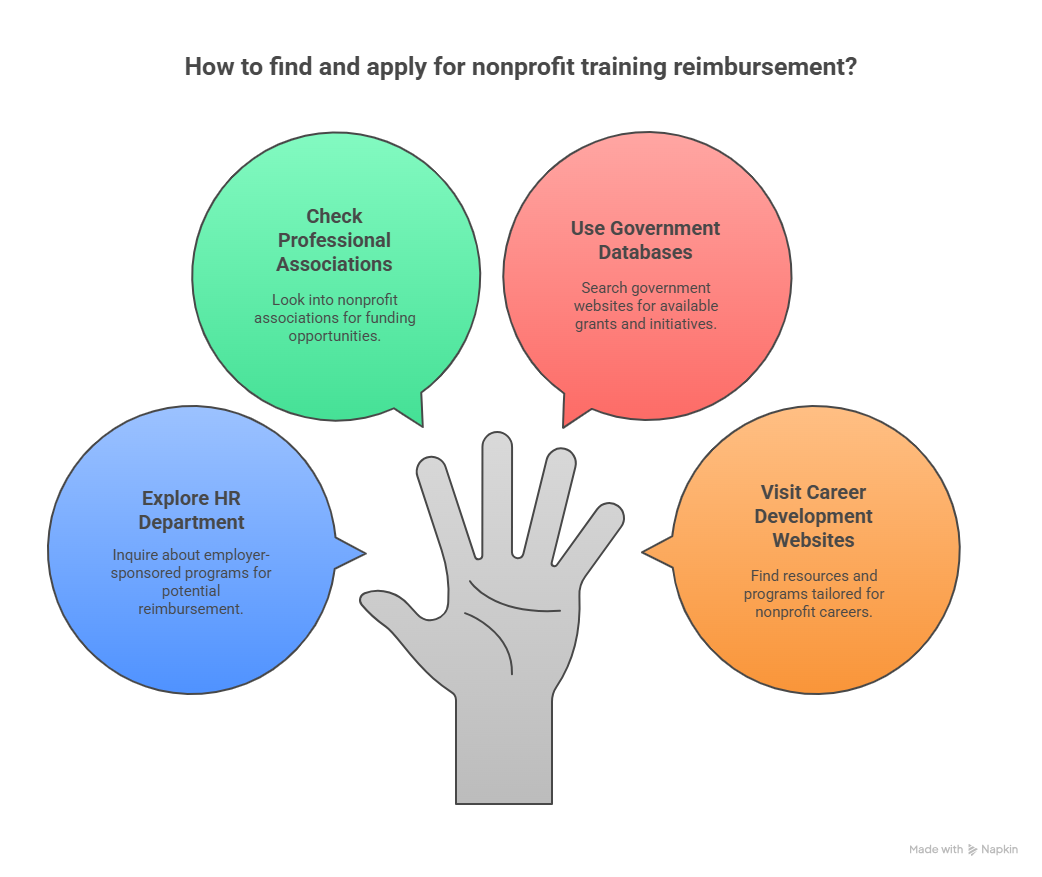It may surprise you to learn that millions of American professionals can upskill without having to pay for it thanks to education reimbursement. Numerous organizations, particularly in the nonprofit sector, provide opportunities for professional development that include funding for additional education.
This improves the organization’s capabilities and productivity in addition to helping the individual. Professionals can stay competitive in their field, learn new skills, and improve their ability to contribute to their organizations by utilizing these reimbursement opportunities.
We’ll examine how nonprofit education reimbursement programs operate, their advantages, and how professionals can take advantage of them as we examine the idea. This introduction lays the groundwork for comprehending the importance of these programs in developing a workforce that is more knowledgeable and driven.
Understanding Nonprofit Training Reimbursement Programs
To assist employees in developing their abilities and making more valuable contributions to their organizations, the nonprofit sector provides a range of training reimbursement programs. These initiatives are intended to help staff members grow continuously and give them the skills and information they need to succeed in their positions.
What Are Nonprofit Training Reimbursement Programs?
Programs for nonprofit training reimbursement enable staff members to pursue additional education or training pertinent to their positions. Tuition, course materials, and occasionally other associated costs are reimbursed under these programs. Fostering employee skill development and improving the general competencies of the nonprofit workforce are the main objectives.
Nonprofits can increase job satisfaction, lower attrition, and create a more capable workforce by funding their employees’ education. From technical skills and project management to leadership and management, these programs can cover a lot of ground.
Types of Skills and Training Covered
Depending on the needs and objectives of the organization, nonprofit training reimbursement programs can cover a variety of skills and training. Typical locations include:
- Leadership development is the process of improving leadership abilities to promote organizational development and transformation.
- Enhancing expertise in particular software, tools, or technologies that are pertinent to the nonprofit’s mission is known as technical skills.
- Project management: Giving employees the tools they need to successfully oversee projects and guarantee their timely and cost-effective completion.
- The development of abilities to improve community involvement, fundraising, and communication.
Take a look at the following table to see the different kinds of training covered:
| Training Area | Description | Benefits |
|---|---|---|
| Leadership Development | Programs focused on enhancing leadership skills, including strategic planning and team management. | Improved organizational leadership, better strategic decision-making. |
| Technical Skills Training | Courses or certifications in specific software or technologies, such as data analysis tools or digital marketing platforms. | Enhanced technical capabilities, improved efficiency in tasks. |
| Project Management | Training on project management methodologies, including planning, execution, and monitoring. | Better project outcomes, improved resource allocation. |
In addition to helping their organizations succeed, nonprofit professionals can make major career advancements by comprehending and utilizing these programs. Through funding for ongoing education or the development of particular skills, these programs are vital tools for personal development.
Benefits of Professional Development in the Nonprofit Sector
Workforce training programs that promote career advancement and organizational effectiveness have a significant positive impact on the nonprofit sector. Nonprofits can improve their services and more effectively accomplish their mission by investing in staff development.
Career Advancement Opportunities
Opportunities for professional development are essential for career progression in the nonprofit industry. Support for training and development increases the likelihood that staff members will take on new tasks and help the company succeed. A nonprofit employee who participates in a leadership development workshop, for example, can acquire the abilities required to successfully manage teams and projects.
In addition to helping the individual, career advancement increases the organization’s ability to accomplish its objectives. Employees who advance in their positions contribute fresh viewpoints and ideas that can spur innovation and advancement.
Organizational Impact and Improved Services
Grants for nonprofit training have a big impact on the caliber of services nonprofits offer. Employees can use newly acquired skills to enhance client services, program delivery, and overall organizational performance. A grant writing training course, for instance, can assist nonprofits in obtaining additional funding, which will enable them to offer more services.
The increased efficacy and efficiency of nonprofit operations is a clear indication of the influence of professional development. Organizations can fulfill their missions and serve their communities more effectively as they grow in capability.
Building a Stronger Nonprofit Workforce
Opportunities for professional development are crucial to creating a robust and resilient nonprofit workforce. Nonprofits can lower turnover and promote a positive work environment by assisting employees in their personal and professional development. A workforce with proper training is better able to manage difficulties and adjust to shifting conditions.
Additionally, a strong workforce is more likely to be motivated and engaged, which boosts output and improves organizational results. Nonprofits lay the groundwork for long-term success and sustainability by investing in their staff.
How to Access Nonprofit Training Funds and Grants
Having access to grants and non-profit training funds can revolutionize your professional path. With so many options, it’s critical to successfully negotiate the process in order to obtain the funds required for your professional growth.
Finding Available Reimbursement Opportunities
Finding potential reimbursement options is the first step in obtaining nonprofit training funding. This entails looking into a number of sources, such as government initiatives, nonprofits, and your employer. Employee reimbursement programs are offered by many nonprofits, so it’s important to inquire with your supervisor or HR department about what options are available.
Key sources to explore:
- The human resources department of your company
- Professional associations that are nonprofit
- Databases and websites run by the government
- Websites devoted to career development for nonprofits
Eligibility Requirements for Continuing Education Funding
To make sure you’re eligible for the reimbursement programs you’re applying for, it’s critical to comprehend the eligibility requirements for continuing education funding. It’s crucial to carefully review the requirements because they can differ greatly between programs.
Typical qualifying requirements are as follows:
- Working for a nonprofit organization that qualifies
- Training’s applicability to your current position
- fulfillment of particular requirements or coursework
- dedication to a nonprofit organization for a predetermined amount of time
Application Process and Documentation
Nonprofit training reimbursement programs usually require a multi-step application process that includes submitting an application, supplying supporting documentation, and waiting for approval. To prevent delays or rejection, it is essential to carefully follow the application instructions.
Required documentation may include:
- A thorough syllabus or course description
- Evidence of registration or enrollment
- A letter outlining how the training fits your role and professional objectives
- The training’s budget or cost breakdown

Tips for a Successful Application
Take into account the following advice to improve your chances of getting funding:
- Match the objectives of your organization with your training: Make it obvious how the training will advance both the nonprofit and your work.
- Give specific budgetary details: To demonstrate your careful planning, break down the training’s expenses.
- Send in your application as soon as possible: Make sure you give the review process enough time.
Conclusion: Investing in Your Nonprofit Career Growth
In the nonprofit sector, where ongoing education and skill development are essential to advancing mission-driven work, investing in your professional development is essential. Professionals have a great opportunity to grow their careers and improve their skills through nonprofit training reimbursement programs.
Through the use of education reimbursement programs and nonprofit training grants, people can acquire the skills and knowledge required to succeed in their positions. Consequently, this adds to their organizations’ overall impact and success.
Prioritizing the skill development of employees benefits the nonprofit workforce overall in addition to the individual. Professionals must stay ahead of the curve and take advantage of resources to support their career goals as the nonprofit sector continues to change.
FAQ
What is a nonprofit training reimbursement program?
One kind of employee benefits program is a nonprofit training reimbursement program, which pays nonprofit professionals for training, classes, or certifications necessary for their position or career progression.
What types of skills and training are typically covered under nonprofit training reimbursement programs?
Programs for nonprofit training reimbursement frequently cover a broad range of training and skills, such as technical skills, project management, fundraising, leadership development, and more. Depending on the program and the organization, different training types may be covered.
How do I find available nonprofit training reimbursement opportunities?
You can begin your search for nonprofit training reimbursement opportunities by asking your employer or human resources department if they have such a program. Additionally, you can look for professional development opportunities, continuing education funding, and nonprofit training grants online.
What are the eligibility requirements for continuing education funding?
Depending on the organization and the particular program, there are different eligibility requirements for continuing education funding. Usually, you have to work for a nonprofit and fulfill requirements like having a certain amount of experience or being in good standing.
How do I apply for nonprofit training funds or grants?
You will normally need to submit an application in order to apply for nonprofit training funds or grants, which may require you to provide supporting documentation like a letter from your employer or a course syllabus. Depending on the program and the organization, the application procedure may change.
What are some tips for a successful application for nonprofit training reimbursement?
Make sure you thoroughly read the eligibility requirements and application instructions, include all necessary supporting documentation, and clearly describe how the training fits with your job or career goals in order to improve your chances of having your application accepted.
Can I use nonprofit training reimbursement programs for online courses or certifications?
Yes, online courses and certifications are covered by a number of nonprofit training reimbursement programs. Make sure the particular certification or course you’re interested in qualifies for reimbursement by checking with the program administrator or your employer.
How do nonprofit training reimbursement programs benefit the nonprofit sector as a whole?
The nonprofit sector gains from nonprofit training reimbursement programs because they contribute to the development of a more capable and resilient workforce, which can result in better services and increased organizational efficacy.


